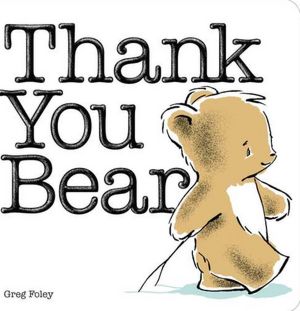 Read book Pig's Picnic by Keiko Kasza. Retell the story using props. Have the children retell the story as you maneuver the props.Early Literacy Aside--Example: Using props is one way to help your child remember the story as they try to retell it. When they can retell a story, it helps their understanding.
Read book Pig's Picnic by Keiko Kasza. Retell the story using props. Have the children retell the story as you maneuver the props.Early Literacy Aside--Example: Using props is one way to help your child remember the story as they try to retell it. When they can retell a story, it helps their understanding.
At the end of storytime hold up the handout of Pig's Picnic (below) and demonstrate how you have cut out the pieces so that the children can retell the story. Early Literacy Aside--Empower: You can strength your children's narrative skills, the ability to tell stories, by taking home this storytime handout, having your children cut out the pictures and retell the story. As they retell the story they may add ideas of their own! pigs-picnic-hand-out.doc Submitted by Laura Mikowski, Hillsboro (OR) Public Libraries

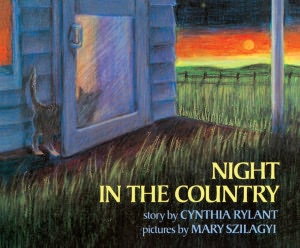
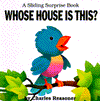 Early Literacy Aside--Explain: There are many ways we can help children enjoy books as we share books together. Children who have positive experiences around books and reading are more likely to stick with learning to read even when it is difficult. I'll be pointing out some ways to share books to make it enjoyable.
As you read the book have children repeat the phrase, "I do. I'm a . . . " with each animal.
Early Literacy Aside--Example: Having the children participate by guessing the animals and responding when the animal appears helps them enjoy the book. This helps support their print motivation.
Early Literacy Aside--Explain: There are many ways we can help children enjoy books as we share books together. Children who have positive experiences around books and reading are more likely to stick with learning to read even when it is difficult. I'll be pointing out some ways to share books to make it enjoyable.
As you read the book have children repeat the phrase, "I do. I'm a . . . " with each animal.
Early Literacy Aside--Example: Having the children participate by guessing the animals and responding when the animal appears helps them enjoy the book. This helps support their print motivation.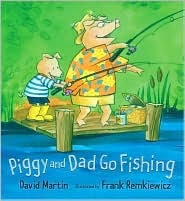 Read the book Piggy and Dad Go Fishing by David Martin. Retell the story using props.Early Literacy Aside--Empower: You encourage dramatic play when you give your children opporutnities to retell stories with your children using things around the house. Having your children retell stories helps them remember the story and also to understand how stories work, with a beginning, a middle and an end. This will help them later in school when they will write their own stories and to understand stories they will read.
Read the book Piggy and Dad Go Fishing by David Martin. Retell the story using props.Early Literacy Aside--Empower: You encourage dramatic play when you give your children opporutnities to retell stories with your children using things around the house. Having your children retell stories helps them remember the story and also to understand how stories work, with a beginning, a middle and an end. This will help them later in school when they will write their own stories and to understand stories they will read.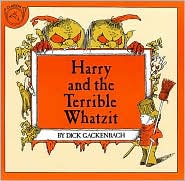 Early Literacy Aside--Explain: Today we are going to focus on vocabulary, one of the early literacy skills. Vocabulary is knowing the meanings of words, of things, concepts, feelings and ideas.Book Introduction: Talk about the word cellar. What is a cellar? Explain the word.
Read the book Harry and the Terrible Whatzit by Dick Gackenbach.
Early Literacy Aside--Example: Go ahead and use words that are unfamiliar to your child. Don't replace words in books that they may not understand, but explain them. This will build their vocabulary.
Early Literacy Aside--Empower: Don't forget when reading to your children at home, don't replace words, but explain them. This helps build their vocabulary and will make it easier for your children to later understand what they read.
Submitted by Janet Boucher, Blue Ridge (VA) Regional Library
Early Literacy Aside--Explain: Today we are going to focus on vocabulary, one of the early literacy skills. Vocabulary is knowing the meanings of words, of things, concepts, feelings and ideas.Book Introduction: Talk about the word cellar. What is a cellar? Explain the word.
Read the book Harry and the Terrible Whatzit by Dick Gackenbach.
Early Literacy Aside--Example: Go ahead and use words that are unfamiliar to your child. Don't replace words in books that they may not understand, but explain them. This will build their vocabulary.
Early Literacy Aside--Empower: Don't forget when reading to your children at home, don't replace words, but explain them. This helps build their vocabulary and will make it easier for your children to later understand what they read.
Submitted by Janet Boucher, Blue Ridge (VA) Regional Library Early Literacy Aside--Example: I am going to read one of my favorite children's books. I love reading this book; it is a lot of fun. When reading with your children, choose books YOU enjoy. Your child picks up on your feelings and understands the enjoyment of books and reading. This supports print motivation, a love of books.Read the book Pete's a Pizza by William Steig putting motions to the words.
Early Literacy Aside--Example: I am going to read one of my favorite children's books. I love reading this book; it is a lot of fun. When reading with your children, choose books YOU enjoy. Your child picks up on your feelings and understands the enjoyment of books and reading. This supports print motivation, a love of books.Read the book Pete's a Pizza by William Steig putting motions to the words. As you read the book, ask the children to identify the animals in the book. Talk about the landscape in the pictures--where in the world might this take place? Use words the children may not know (arctic, icebergs, ice floes, glaciers, etc.). Also, talk about Tacky the Penguin's personality, his uniqueness and originality, explaining words children may not know. For an activity, have children and adults draw and color a penguin however they want.Early Literacy Aside--Empower: We used lots of interesting words today with Tacky the Penquin, some were not even in the book. This helps develop your child's vocabulary. On your way home, talk about being creative and ways your child is unique, using some of the interesting words we used today and adding your own. Through talking and talking about your children's drawings there are many opportunities to expand your child's vocabulary.
As you read the book, ask the children to identify the animals in the book. Talk about the landscape in the pictures--where in the world might this take place? Use words the children may not know (arctic, icebergs, ice floes, glaciers, etc.). Also, talk about Tacky the Penguin's personality, his uniqueness and originality, explaining words children may not know. For an activity, have children and adults draw and color a penguin however they want.Early Literacy Aside--Empower: We used lots of interesting words today with Tacky the Penquin, some were not even in the book. This helps develop your child's vocabulary. On your way home, talk about being creative and ways your child is unique, using some of the interesting words we used today and adding your own. Through talking and talking about your children's drawings there are many opportunities to expand your child's vocabulary. Early Literacy Aside--Explain: Songs are a great way to incorporate the early literacy skill, phonological awareness. Hearing and learning animal sounds helps your children hear the smaller sounds in words and singing emphasizes different syllables. This helps your children later to sound out words.
Submitted by Wendy B. Rancier, Roanoke County (VA) Public Library
Early Literacy Aside--Explain: Songs are a great way to incorporate the early literacy skill, phonological awareness. Hearing and learning animal sounds helps your children hear the smaller sounds in words and singing emphasizes different syllables. This helps your children later to sound out words.
Submitted by Wendy B. Rancier, Roanoke County (VA) Public Library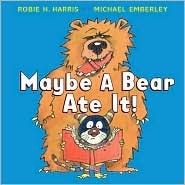 This book is wonderful for how, why, when and where questions! There are several pictures in this book with no words. When you come to these pictures, ask the children what the character is doing, what is missing and how the character is feeling.Read the book Maybe a Bear Ate It by Robie Harris
Early Literacy Aside--Example: Asking questions using what and how, as I did when I read the story will help strengthen your children's narrative skills, which in turn helps to build comprehension ability as the child begins to read.
This book is wonderful for how, why, when and where questions! There are several pictures in this book with no words. When you come to these pictures, ask the children what the character is doing, what is missing and how the character is feeling.Read the book Maybe a Bear Ate It by Robie Harris
Early Literacy Aside--Example: Asking questions using what and how, as I did when I read the story will help strengthen your children's narrative skills, which in turn helps to build comprehension ability as the child begins to read. Read the book Snap! by Marcia Vaughan.Early Literacy Aside--Example: This book lends itself to retelling events which helps your child understand the story. Encourage your child with questons that leave room for them to describe what they hear or see. I used questions like, "What did Joey do when his Mom fell asleep?" and "Who did he meet?"
Early Literacy Aside--Empower: The ability to retell a story is an important skill for children to have in order to understand what they are reading. Predicting what happens next and acting it out, or as it's usually called, pretend playing, is a fun way to retell a story and to gain background knowldge along the way.
Read the book Snap! by Marcia Vaughan.Early Literacy Aside--Example: This book lends itself to retelling events which helps your child understand the story. Encourage your child with questons that leave room for them to describe what they hear or see. I used questions like, "What did Joey do when his Mom fell asleep?" and "Who did he meet?"
Early Literacy Aside--Empower: The ability to retell a story is an important skill for children to have in order to understand what they are reading. Predicting what happens next and acting it out, or as it's usually called, pretend playing, is a fun way to retell a story and to gain background knowldge along the way.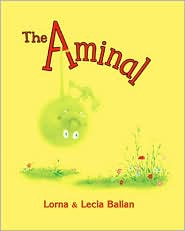 Early Literacy Aside--Explain: Narrative skills is helping your child tell a story. Researchers say this is an important skill towards your child learning to read, understanding what he will read. In this storytime we will have fun while using narrative skills.During the storytime:
Early Literacy Aside--Example: In this story we will be using narrative skills to tell our story and to talk about the events taking place. Narrative skills is one of the early literacy skills that help your children learn to read. This includes giving your children time to think about and answer questions about the story. Listen as I ask questions that cannot be answered with just yes or no.
Read the book.
Early Literacy Aside--Empower: Ask your child about storytime today when you get home and help them retell one of the stories. You'll be continuing to develop your child's narrative skills!
Early Literacy Aside--Explain: Narrative skills is helping your child tell a story. Researchers say this is an important skill towards your child learning to read, understanding what he will read. In this storytime we will have fun while using narrative skills.During the storytime:
Early Literacy Aside--Example: In this story we will be using narrative skills to tell our story and to talk about the events taking place. Narrative skills is one of the early literacy skills that help your children learn to read. This includes giving your children time to think about and answer questions about the story. Listen as I ask questions that cannot be answered with just yes or no.
Read the book.
Early Literacy Aside--Empower: Ask your child about storytime today when you get home and help them retell one of the stories. You'll be continuing to develop your child's narrative skills!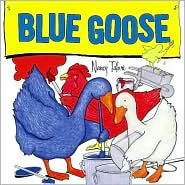 Early Literacy Aside--Explain: Researchers have found that 95% of children's attention goes to the pictures in the book. When you run your fingers under the title as you read it, this helps show them you are reading the text, not the pictures. This is part of print awareness and is one of the skills children need to learn to read.During the storytime--Read the book running your finger under the repeated phrases.
Early Literacy Aside--Example: You can run your finger under the repeated phrases to match the text to the words. Then your action doesn't get in the way of the story. Read the book running your finger under the repeated phrases.
Early Literacy Aside--Empower: When you read withyour children at home, hold the book upside down or backwards and see if your child notices. Be sure to turn the book if a page is in a different direction. Theis helps develop their print awareness.
Submitted by Melissa Davis, Bedford (VA) Public Library
Early Literacy Aside--Explain: Researchers have found that 95% of children's attention goes to the pictures in the book. When you run your fingers under the title as you read it, this helps show them you are reading the text, not the pictures. This is part of print awareness and is one of the skills children need to learn to read.During the storytime--Read the book running your finger under the repeated phrases.
Early Literacy Aside--Example: You can run your finger under the repeated phrases to match the text to the words. Then your action doesn't get in the way of the story. Read the book running your finger under the repeated phrases.
Early Literacy Aside--Empower: When you read withyour children at home, hold the book upside down or backwards and see if your child notices. Be sure to turn the book if a page is in a different direction. Theis helps develop their print awareness.
Submitted by Melissa Davis, Bedford (VA) Public Library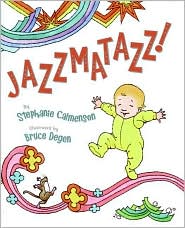 Early Literacy Aside--Example: What a fun and noisy book this is! Listen to the different kinds of sounds that music can make like plink, plink and bang-a-bang along with the jazz rhythm of Doo-dat, diddy-dat, diddy-dat, doo! As children learn to hear and make not only animal sounds but sounds of many different things, they are developing phonological awareness which will later help them sound out words as they learn to read.
Early Literacy Aside--Example: What a fun and noisy book this is! Listen to the different kinds of sounds that music can make like plink, plink and bang-a-bang along with the jazz rhythm of Doo-dat, diddy-dat, diddy-dat, doo! As children learn to hear and make not only animal sounds but sounds of many different things, they are developing phonological awareness which will later help them sound out words as they learn to read.
